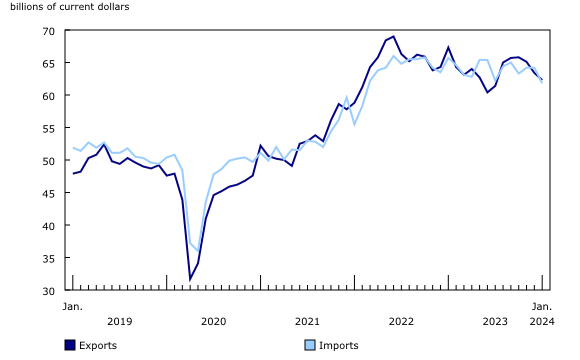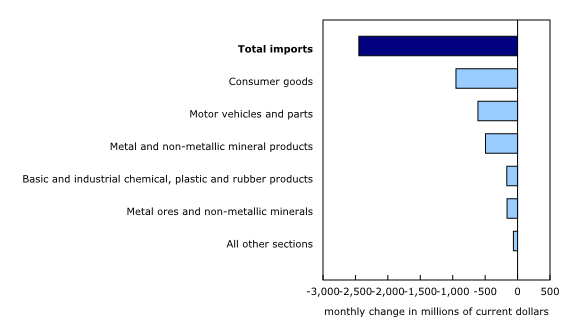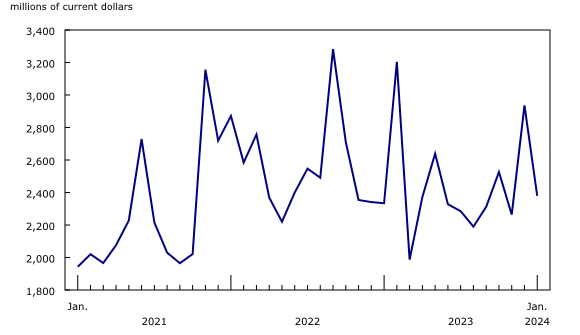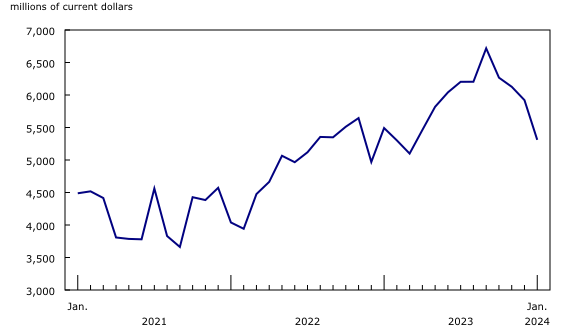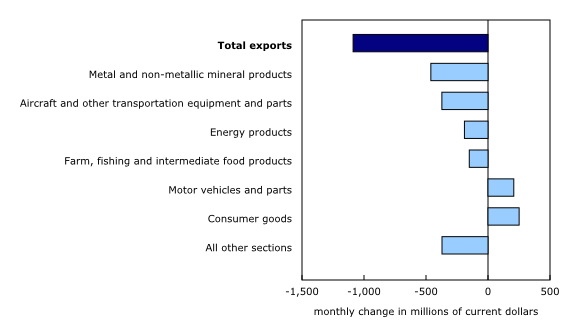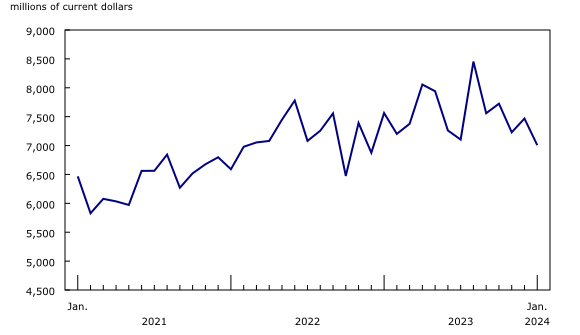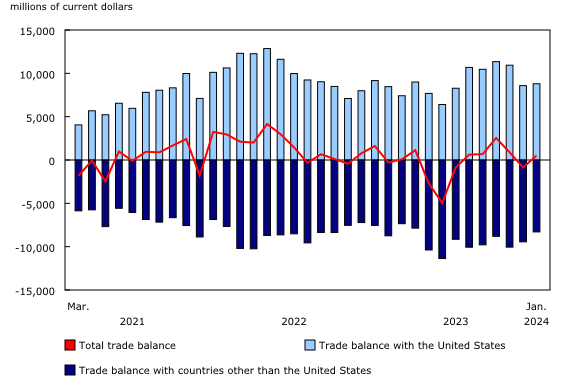Canadian international merchandise trade, January 2024
Released: 2024-03-07
In January, Canada's merchandise imports decreased 3.8%, while exports fell 1.7%. As a result, Canada's merchandise trade balance changed position for a second consecutive month, moving from a deficit of $863 million in December to a surplus of $496 million in January. The January surplus is close to the typical bounds for monthly revisions to imports and exports.
Consult the "International trade monthly interactive dashboard" to explore the most recent results of Canada's international trade in an interactive format.
Following a surge in December, imports of consumer goods fall back in January
Total imports decreased 3.8% in January to $61.8 billion, the lowest level since February 2022. Overall, 7 of the 11 product sections were down. On a year-over-year basis, imports were down 6.0% in January 2024. In real (or volume) terms, total imports fell 4.1% in January compared with the previous month.
Following a 9.8% increase in December, imports of consumer goods declined 7.1% in January, erasing a large part of the gain made in the previous month. As was the case in December, imports of pharmaceutical products (-19.0%) contributed most to the monthly movement in the product section in January. Imports of pharmaceutical products posted a rare December increase because of atypical high-value imports from the United States, and these shipments did not repeat in January. Excluding pharmaceutical products, imports of consumer goods were down 3.8% in January.
Imports of motor vehicles and parts (-5.2%) also decreased in January, a fourth consecutive decline. This string of decreases followed six consecutive monthly increases from April to September 2023, when an all-time high was reached. Lower imports of passenger cars and light trucks (-10.3%) were largely behind the decline in January 2024, amid lower global production. This slowdown was influenced by several factors, including plant retooling, supply issues, strikes, as well as cooling demand.
Imports of metal and non-metallic mineral products (-9.2%) also contributed to the overall decrease in January. Following two consecutive monthly increases, imports of unwrought gold, silver, and platinum group metals (-33.5%), a category mainly composed of unwrought gold, posted the largest monthly decline. High-value imports of gold powder were recorded in December and did not continue in January. There were also lower shipments of gold traded within the banking sector in January.
Exports of metal products and aircraft decline
Total exports decreased 1.7% in January, a third consecutive monthly decline. Decreases were observed in 8 of the 11 product sections. Exports were down 7.5% in January compared with the same month in 2023, when exports reached a peak. In real (or volume) terms, total exports fell 1.8% in January 2024 compared with December 2023.
Exports of metal and non-metallic mineral products (-6.2%) posted the largest decline in January 2024. Many product groups contributed to the decrease, including unwrought gold, silver, and platinum group metals (-5.3%); waste and scrap of metal (-20.1%); basic and semi-finished products of non-ferrous metals and non-ferrous metal alloys (-26.5%); and unwrought nickel and nickel alloys (-26.9%).
Exports of aircraft and other transportation equipment and parts (-13.9%) also fell in January. Following an increase of 27.9% in December, exports of aircraft decreased 25.4% in January and contributed the most to the decline. Exports of aircraft are highly seasonal, and the timing of delivery of a single unit can result in strong fluctuations on a month-to-month basis. Fewer aircraft were delivered to the United States in January. The decrease in the month followed a strong year for exports of aircraft, which reached $11.0 billion in 2023, the second highest annual total on record.
Canadian exports and imports decrease with both the United States and other countries
Imports from countries other than the United States were down 7.3% in January, partly because of lower imports from China (various products) and South Korea (passenger cars and light trucks). Exports to countries other than the United States (-4.2%) also fell, in large part because of lower exports to Italy (aircraft and pharmaceutical products), China (coal), Norway (nickel), and Germany (crude oil).
Canada's trade deficit with countries other than the United States narrowed from $9.4 billion in December to $8.3 billion in January.
Imports from the United States decreased 1.7% in January, partly because of lower imports of motor vehicles and parts and pharmaceutical products. Meanwhile, exports to that country fell 1.0%, primarily because of lower exports of aircraft. As a result, Canada's merchandise trade surplus with the United States widened slightly from $8.6 billion in December to $8.8 billion in January.
Revisions to December merchandise export and import data
Imports in December, originally reported at $64.4 billion in the previous release, were revised to $64.2 billion in the current reference month's release. Exports in December, originally reported at $64.1 billion in the previous release, were revised to $63.4 billion in the current reference month's release.
Monthly trade in services
In January, monthly service exports were down 1.6% to $17.0 billion. Meanwhile, imports were up 1.5% to $18.3 billion.
When international trade in goods and services are combined, exports decreased 1.7% to $79.3 billion in January, while imports fell 2.6% to $80.1 billion. As a result, Canada's total trade deficit with the world narrowed from $1.6 billion in December to $779 million in January.
Did you know we have a mobile app?
Get timely access to data right at your fingertips by downloading the StatsCAN app, available for free on the App Store and on Google Play.
Note to readers
Information on concepts and methods used for the monthly release of Canada's international merchandise trade is now available online. Please see Notes on the monthly release of Canadian international merchandise trade for more details.
For a detailed overview of the Canadian International Merchandise Trade program, please see "Guide to Canadian International Merchandise Trade Statistics."
Important changes to the collection of data on Canada's imports with the release of CBSA Assessment and Revenue Management (CARM)
Statistics on merchandise imports published by Statistics Canada are compiled from administrative records received from the Canada Border Services Agency (CBSA), specifically documentation that importers must file to account for their goods, which are used to assess duties and taxes owed.
The CBSA Assessment and Revenue Management (CARM) digital initiative will change how CBSA assesses and collects duties and taxes on commercial goods imported into Canada. On May 13, 2024, CARM will become the official system of record that importers and other trade chain partners will use to pay duties and taxes.
The CARM initiative will introduce new functionality and requirements to trade chain partners submitting data as well as receiving organizations such as Statistics Canada. As trade chain partners and organizations transition to CARM, there may be impacts on patterns in the data submitted to CBSA, or delays in the receipt of data at Statistics Canada. While Statistics Canada will be closely monitoring incoming data and responding as needed, users of statistics on merchandise imports should be aware of these potential impacts and the increased likelihood of large revisions in the future, especially with the publication of data for the April 2024 and May 2024 reference months.
Statistics Canada will provide further updates on the potential impacts of the CARM initiative on Canadian International Merchandise Trade statistics as new information becomes available.
Note on the potential US government shutdown
Under a 1990 agreement between Canada and the United States, each country uses the other's import data to produce statistics on its exports. If a US government shutdown were to occur and affect the Department of Commerce, the United States Census Bureau would close, and Statistics Canada would not receive data on Canada's exports to the United States for the duration of the shutdown. As in the past, a prolonged shutdown could lead to a postponement of the publication of Canadian International Merchandise Trade statistics. Statistics Canada is closely monitoring this situation and will provide further information on potential impacts to its statistical programs as needed.
Real-time data table
The real-time data table 12-10-0165-01 will be updated on March 18.
Next release
Data on Canadian international merchandise trade for February will be released on April 4.
Products
The product "International trade monthly interactive dashboard" (71-607-X) is now available. This new interactive dashboard is a comprehensive analytical tool that presents monthly changes in Canada's international merchandise trade data on a balance-of-payments basis, fully supporting the information presented every month in the Daily release.
The product "The International Trade Explorer" (71-607-X) is now available online.
The online Canadian International Merchandise Trade Database is no longer available. It has been replaced by the Canadian International Merchandise Trade Web Application (71-607-X), a modern tool that provides trade data users with a number of enhancements.
The updated "Canada and the World Statistics Hub" (13-609-X) is now available online. This product illustrates the nature and extent of Canada's economic and financial relationship with the world using interactive charts and tables. It provides easy access to information on trade, investment, employment and travel between Canada and a number of countries, including the United States, the United Kingdom, Mexico, China, Japan, Belgium, Italy, the Netherlands and Spain.
Contact information
For more information, or to enquire about the concepts, methods or data quality of this release, contact us (toll-free 1-800-263-1136; 514-283-8300; infostats@statcan.gc.ca) or Media Relations (statcan.mediahotline-ligneinfomedias.statcan@statcan.gc.ca).
- Date modified:


